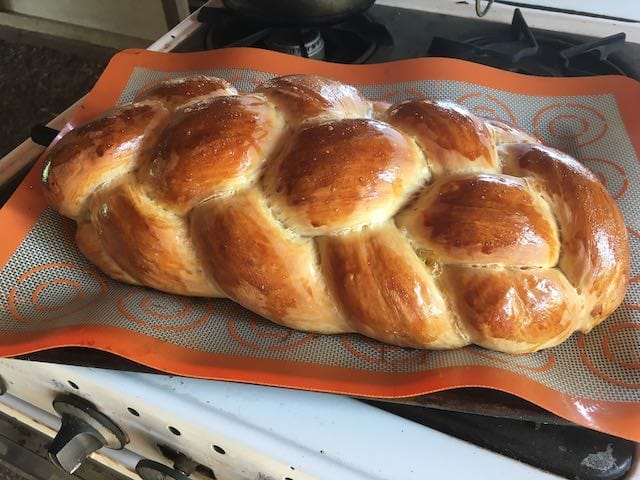Sourdough Challah

Contains Gluten
Dairy Free
I found this wonderful recipe at thegingeredwhisk.com and have modified it a bit to make it my own. Please see the original recipe on the blog for all credit, referral links, photos, etc.
Wednesday:
Freshen up the sourdough starter and leave out so it will be fully active by Thursday afternoon.
Thursday afternoon or evening:
Make the Levain.
Levain Ingredients:
- 60 grams (¼ cup) very active, fully fermented sourdough starter at 100% hydration
- 1/3 cup (80 grams) warm water
- 1 cup (135 grams) flour: I like to use about half whole wheat and half white
Levain Instructions:
- The levain is like a bigger, specific hydration starter. You need to use ½ cup of fed and active 100% hydration starter to make this stiff 50% hydration levain. (Note that the ingredients above say to use ¼ cup of starter. I’ve been using ¼ cup and it’s been working out fine.)
- In a medium mixing bowl, combine the active 100% hydration starter with the warm water and flour. Mix until combined. This is a stiff starter, so it will take some work to get all the flour mixed in. Do not add extra water. You might need to do a little kneading to get it to all mix in. If all the flour won’t mix in, it’s OK, just get as much as you can.
- Cover the bowl with a lid or plastic wrap and allow to sit on the counter overnight 8-12 hours.
Friday Morning
Make the dough.
Dough Ingredients:
- ¼ cup (60 grams) warm water
- 3 large eggs, plus 1 for glazing
- 1 ½ tsp (8 grams) salt
- ¼ cup (55 grams) vegetable oil
- 3 TBSP (65 grams) mild honey OR 1/3 cup (60 grams) sugar
- about 3 cups (400 grams) flour (½ cup whole wheat, then about 2½ cups white, or whatever the dough needs)
- Optional Toppings: sesame seeds or poppy seeds
Dough Instructions:
- In a large mixing bowl, whisk together the 60 grams warm water, eggs, salt, vegetable oil and honey. Whisk until the salt is dissolved.
- Add the whole wheat flour, and most of the white flour, all at once. Leave aside about a half cup of white flour to see if the dough ends up wanting it. With your hands or a wooden spoon, mix the flour in.
- When the mixture is a shaggy ball, scrape it out onto your work surface.
- Add the levain from the night before, and knead until the dough is smooth (it should take about 10 minutes by hand). You might need to lightly sprinkle your counter with a small amount of flour as you knead to keep the dough from sticking. The dough will be firm and should feel almost like modeling clay and should be easy to work with even if a little bit sticky. If the dough is too firm to knead easily, add a tablespoon or two of water to it. If the dough is too wet, add a tablespoon or two of flour.
- Place the dough in a clean oiled bowl and cover with plastic wrap.
- Allow the dough to ferment at room temperature for 2 hours. It will probably not rise much, if at all.
Continue 2 hours later:
- Line a baking sheet with parchment paper.
- Braid the challah into one big loaf or two small ones. I’ve actually only made one big one from the recipe, so can’t vouch for the timing of two small ones.
- Cover the baking sheet with plastic wrap and allow the loaf to proof until tripled in size, about 5 hours. The time it takes will depend on the temperature and humidity level in your house; if it is cooler it could take longer, and if it is warmer it could take less time. Watch the dough, not the clock. It will be fully proofed when you can gently dent it with your knuckle and the dough springs back.
Continue after dough has risen:
- Arrange the oven racks so you have one in the upper third of your oven, with nothing above it.
- Preheat your oven to 350 F and let it get nice and hot – at least 15-20 minutes before baking.
- In a small bowl, beat the remaining egg with a pinch of salt.
- Brush the egg glaze over the loaf.
- If desired, you can sprinkle the loaf with poppy seeds or sesame seeds, or you can leave it plain.
- Bake for 35 to 40 minutes, or until well browned. After the first 20 minutes of baking, rotate the baking sheet in the oven to promote even browning. If the bread is browning too fast, tent it with foil.